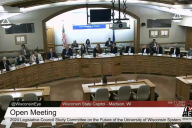You have /5 articles left.
Sign up for a free account or log in.
Some 20 professional organizations, from the American Anthropological Association to the Society of Biblical Literature, on Thursday issued a joint statement opposing the University of Wisconsin at Stevens Point’s plan to cut 13 majors -- including those in English, history, political science, sociology and all three of the foreign languages offered. The plan has attracted widespread criticism in Wisconsin and outside the state, as the humanities-heavy cuts are linked to program expansions in what the university has described as more in-demand fields. They include business, chemical engineering, computer information systems, conservation law enforcement, fire science and graphic design. Stevens Point’s initiative, which will likely involved tenured faculty layoffs, is also shaping up to be the first application of controversial changes to state tenure law and University of Wisconsin System policies making it easier to terminate tenured professors.
The professional associations’ letter of opposition says, in part, “We recognize the reality that effective university leaders today must not only make changes, but in some cases fundamentally reimagine their institutions in order to chart a sustainable course for the future. However, all colleges and universities benefit from strong programs in the humanities, and it is especially important for regional public institutions, which serve large populations of first-generation college students, students of color, and students from families of limited means, to provide access to in-depth education in the full range of humanities and social science programs.” By focusing on preparation “only for narrowly defined jobs,” the associations say, “Stevens Point administrators risk leaving students with considerably poorer preparation for the full range of careers most Americans will experience in a working lifetime.”
Stevens Point has previously defended its plan as one that makes the best of use of scarce financial resources and is most likely to stabilize enrollment.









